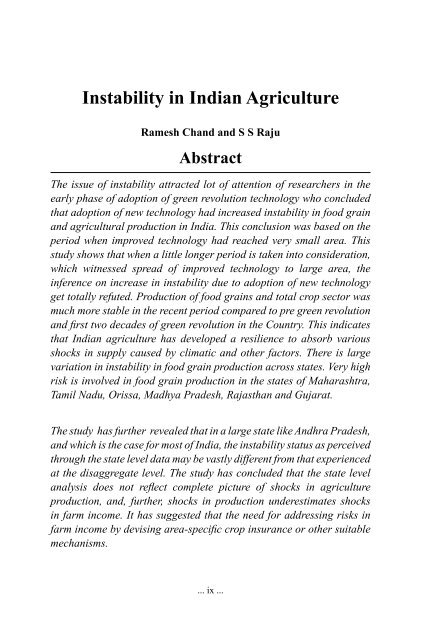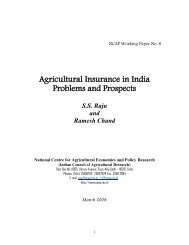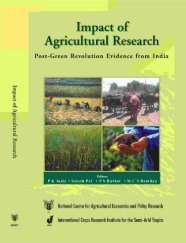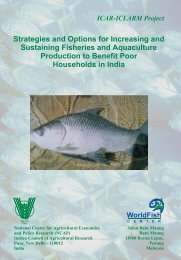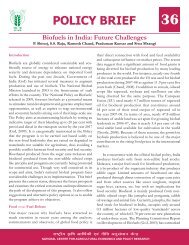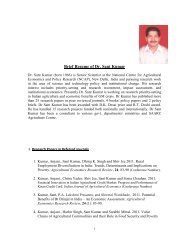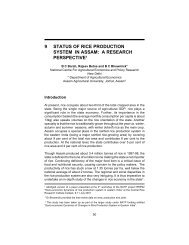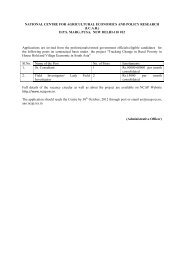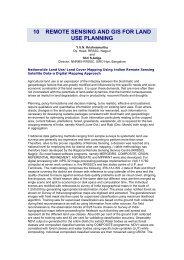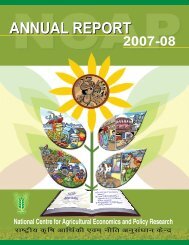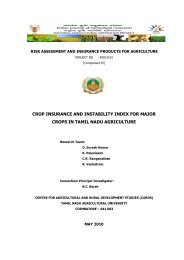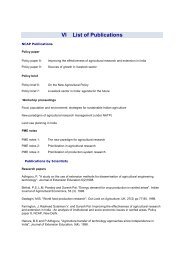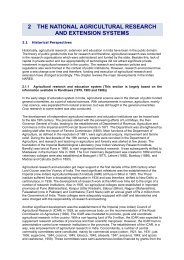Instability in Indian Agriculture - NCAP
Instability in Indian Agriculture - NCAP
Instability in Indian Agriculture - NCAP
Create successful ePaper yourself
Turn your PDF publications into a flip-book with our unique Google optimized e-Paper software.
<strong>Instability</strong> <strong>in</strong> <strong>Indian</strong> <strong>Agriculture</strong><br />
Ramesh Chand and S S Raju<br />
Abstract<br />
The issue of <strong>in</strong>stability attracted lot of attention of researchers <strong>in</strong> the<br />
early phase of adoption of green revolution technology who concluded<br />
that adoption of new technology had <strong>in</strong>creased <strong>in</strong>stability <strong>in</strong> food gra<strong>in</strong><br />
and agricultural production <strong>in</strong> India. This conclusion was based on the<br />
period when improved technology had reached very small area. This<br />
study shows that when a little longer period is taken <strong>in</strong>to consideration,<br />
which witnessed spread of improved technology to large area, the<br />
<strong>in</strong>ference on <strong>in</strong>crease <strong>in</strong> <strong>in</strong>stability due to adoption of new technology<br />
get totally refuted. Production of food gra<strong>in</strong>s and total crop sector was<br />
much more stable <strong>in</strong> the recent period compared to pre green revolution<br />
and first two decades of green revolution <strong>in</strong> the Country. This <strong>in</strong>dicates<br />
that <strong>Indian</strong> agriculture has developed a resilience to absorb various<br />
shocks <strong>in</strong> supply caused by climatic and other factors. There is large<br />
variation <strong>in</strong> <strong>in</strong>stability <strong>in</strong> food gra<strong>in</strong> production across states. Very high<br />
risk is <strong>in</strong>volved <strong>in</strong> food gra<strong>in</strong> production <strong>in</strong> the states of Maharashtra,<br />
Tamil Nadu, Orissa, Madhya Pradesh, Rajasthan and Gujarat.<br />
The study has further revealed that <strong>in</strong> a large state like Andhra Pradesh,<br />
and which is the case for most of India, the <strong>in</strong>stability status as perceived<br />
through the state level data may be vastly different from that experienced<br />
at the disaggregate level. The study has concluded that the state level<br />
analysis does not reflect complete picture of shocks <strong>in</strong> agriculture<br />
production, and, further, shocks <strong>in</strong> production underestimates shocks<br />
<strong>in</strong> farm <strong>in</strong>come. It has suggested that the need for address<strong>in</strong>g risks <strong>in</strong><br />
farm <strong>in</strong>come by devis<strong>in</strong>g area-specific crop <strong>in</strong>surance or other suitable<br />
mechanisms.<br />
... ix ...


